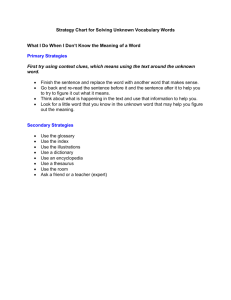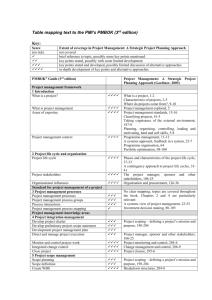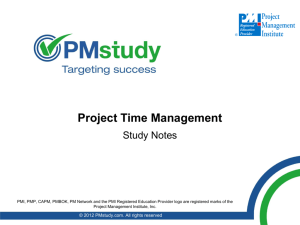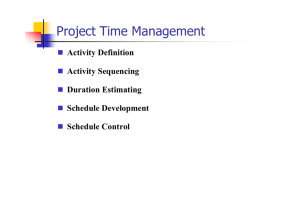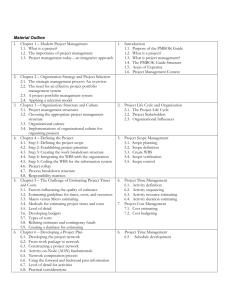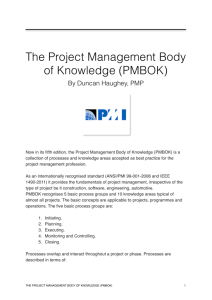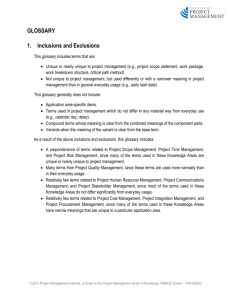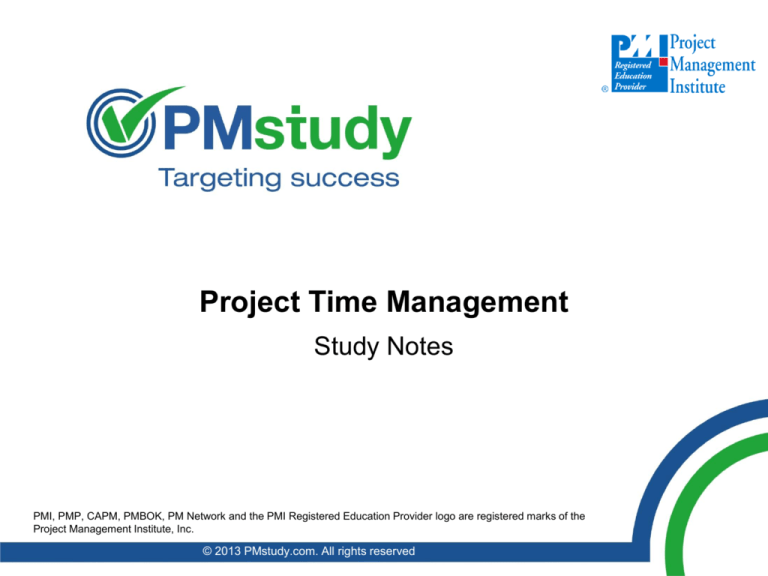
Project Time Management
Study Notes
PMI, PMP, CAPM, PMBOK, PM Network and the PMI Registered Education Provider logo are registered marks of the
Project Management Institute, Inc.
© 2013 PMstudy.com. All rights reserved
Points to Note
• Please read chapter 6 from Project Management Institute, A Guide to the Project
Management Body of Knowledge, (PMBOK® Guide) – Fifth Edition, Project Management
Institute, Inc., 2013 (pages 141-192).
• The study notes explain topics that are important for PMP® exam preparation, and you can
expect several questions from these topics.
• Pay close attention to all the terms used. It is very important to understand all the concepts
discussed in this chapter.
• Try to relate the concepts to real life examples.
• After reading the study notes, please answer the chapter test questions in this knowledge
area. The chapter questions improve your understanding of the concepts discussed in the
study notes.
© 2013 PMstudy.com. All rights reserved
2
What is Project Time Management?
• *Project Time Management includes processes required to manage the timely completion of
the project.
• Processes involved in the project time management include:
◦ Plan Schedule Management
◦ Define Activities
◦ Sequence Activities
◦ Estimate Activity Resources
◦ Estimate Activity Durations
◦ Develop Schedule
◦ Control Schedule
• Each of these processes occur at least once in every project and in one or more project
phases (if the project is divided into phases).
Please refer to PMBOK® Guide - Fifth Edition, figure 6-1, page 143. This provides an
overview of the processes in Project Time Management.
*This definition is taken from the Glossary of the Project Management Institute, A Guide to the Project Management Body of Knowledge, (PMBOK® Guide) – Fifth Edition, Project
Management Institute, Inc., 2013
© 2013 PMstudy.com. All rights reserved
3
Plan Schedule Management
• *Process of establishing the policies, procedures, and documentation for planning, developing,
managing, executing, and controlling the project schedule.
• Guides and directs how the project schedule will be managed throughout the project.
• Some of the main inputs are:
◦
◦
Project Management Plan
Project Charter
• Tools and Techniques used are:
◦
◦
◦
Expert judgment
Analytical techniques
Meetings
• Schedule management plan is the only output of this process
• *The schedule management plan is a component of the project management plan that establishes
the criteria and the activities for developing, monitoring, and controlling the schedule.
• The schedule management plan could be either formal or informal, highly detailed or broadly framed.
*These definitions are taken from the Glossary of the Project Management Institute, A Guide to the Project Management Body of Knowledge, (PMBOK® Guide) – Fifth Edition,
Project Management Institute, Inc., 2013
© 2013 PMstudy.com. All rights reserved
4
Define Activities
• *Process of identifying and documenting the specific actions to be performed to produce the
project deliverables.
• Activities are smaller decomposed components of the project work packages, which represent
the work necessary to complete the work package.
• Tools and Techniques used in Define Activities process:
◦ Decomposition
◦ Rolling wave planning
◦ Expert judgment
• Outputs of Define Activities process are:
◦ Activity list
◦ Activity attributes
◦ Milestone list
*This definition is taken from the Glossary of the Project Management Institute, A Guide to the Project Management Body of Knowledge, (PMBOK® Guide) – Fifth Edition, Project
Management Institute, Inc., 2013
© 2013 PMstudy.com. All rights reserved
5
Decomposition
• *A technique used for dividing and subdividing the project scope and project deliverables into
smaller, more manageable parts.
• Subdivides the project work packages into activities
• Provides better management control
• Leads to activities, the lowest level of the work packages in the Define Activities process
• Leads to the work package, the lowest level in the Work Breakdown Structure (WBS) in the
Create WBS process, where the deliverables are identified
• Process can involve team members. This can lead to better and more accurate results.
*This definition is taken from the Glossary of the Project Management Institute, A Guide to the Project Management Body of Knowledge, (PMBOK® Guide) – Fifth Edition, Project
Management Institute, Inc., 2013
© 2013 PMstudy.com. All rights reserved
6
Sequence Activities
• Identifies and documents relationships among project activities
• Uses logical relationships
• Can be performed by using manual or automated techniques or project management software
• *Some important inputs are:
◦ Schedule management plan
◦ Activity list
◦ Activity attributes
◦ Milestone list
◦ Project scope statement
• Tools and Techniques used for the Sequence Activity process are:
◦ Precedence diagramming method (PDM)
◦ Dependency determination
◦ Leads and lags
Project Management Institute, A Guide to the Project Management Body of Knowledge, (PMBOK® Guide) – Fifth Edition, Project Management Institute, Inc., 2013, Page 153.
© 2013 PMstudy.com. All rights reserved
7
Precedence Diagramming Method (PDM)
• *A technique used for constructing a schedule model in which activities are represented by
nodes and are graphically linked by one or more logical relationships to show the sequence in
which the activities are to be performed.
• Activity–On-Node (AON) is one of the methods representing precedence diagram. It is used by
most project management software packages
• Includes four types of dependencies or logical relationships:
◦
◦
◦
◦
Finish-to-start (FS)
Finish-to-finish (FF)
Start-to-start (SS)
Start-to-finish (SF)
• Most commonly used precedence relationship: the finish-to-start (FS)
• Does not use dummy activities
• Does not allow for loops or conditional branches
*This definition is taken from the Glossary of the Project Management Institute, A Guide to the Project Management Body of Knowledge, (PMBOK® Guide) – Fifth Edition, Project
Management Institute, Inc., 2013
© 2013 PMstudy.com. All rights reserved
8
Activity on Node
• Activity on Node (AON) or Precedence Diagramming Method (PDM) showcases the interdependencies among various project activities.
• This technique is used to draw the project schedule network diagrams; e.g. Critical Path
Network Diagram to identify the Critical path and the float for each activity
• In an AON diagram, each rectangle box represents a node and a project activity. These
rectangular boxes are connected using arrows to the succeeding activity box thereby
portraying the project dependencies.
• Activity on Node uses four types of dependencies.
◦ Finish to Start (FS): The end of one activity is required for the start of the next one. This is
the most common dependency
◦ Finish to Finish (FF): The end of the first activity is required for the second activity to finish
◦ Start To Start (SS): The second activity starts only after the first activity has started
◦ Start to Finish (SF): second activity cannot be finished until first activity starts.
© 2013 PMstudy.com. All rights reserved
9
Conditional Diagramming Methods
• Allows non-sequential loops or conditional branches
• Example:
◦
◦
GERT (graphical evaluation and review techniques)
System dynamics
© 2013 PMstudy.com. All rights reserved
10
Types of Dependencies
• Mandatory dependencies:
◦
◦
◦
◦
Also referred to as hard logic
Required as per contract or inherent in the nature of the work
Usually involve physical limitations (e.g., you cannot build the ceiling until walls are constructed)
Are determined by the project management team during the activity sequencing process
• Discretionary dependencies:
◦
◦
◦
Also referred to as preferred logic, preferential logic, or soft logic
Are determined by the project management team during the activity sequencing process
Should be used with care and well documented, since they may limit later scheduling options
• External dependencies:
◦
◦
Are determined by the project management team during the activity sequencing process
*Involve a relationship between project and non-project activities such as activities outside the
project team’s control (e.g., dependence on external sources for deliveries, environmental factors
governed by statutes, etc.)
• Internal dependencies:
◦ Are determined by the project management team during the activity sequencing process
◦ Involve a precedence relationship between project activities
Project Management Institute, A Guide to the Project Management Body of Knowledge, (PMBOK® Guide) – Fifth Edition, Project Management Institute, Inc., 2013, Page 158
© 2013 PMstudy.com. All rights reserved
11
Project Schedule Network Diagrams
• Is the main output of Sequence activities
• *A graphical representation of the logical relationships among the project schedule activities.
• Can be produced manually or using project management software
• Can have full project details, or have one or more summary activities
*This definition is taken from the Glossary of the Project Management Institute, A Guide to the Project Management Body of Knowledge, (PMBOK® Guide) – Fifth Edition, Project
Management Institute, Inc., 2013
© 2013 PMstudy.com. All rights reserved
12
Estimate Activity Resources
• Estimates the type and quantities of material, human resource, equipment, or supplies required to
perform each activity.
• Identifies the quality, type, and characteristics of resources required to complete the activity.
• Coordinates closely with Estimate Costs process
• *Some important inputs are:
◦ Schedule management plan
◦ Activity list
◦ Activity attributes
◦ Resource calendars
◦ Risk register
◦ Activity cost estimates
• *Tools and Techniques used are:
◦
◦
◦
◦
◦
Expert judgment
Alternative analysis
Published estimating data
Bottom-up estimating
Project management software
Project Management Institute, A Guide to the Project Management Body of Knowledge, (PMBOK® Guide) – Fifth Edition, Project Management Institute, Inc., 2013, Page 161
© 2013 PMstudy.com. All rights reserved
13
Outputs of Estimate Activity Resources
• Activity Resource Requirements
◦ *The types and quantities of resources required for each activity in a work package
◦ Determines the estimated resources for each work package and each work period by
aggregating their requirements like the types and the quantities
◦ Will be documented by including basis of estimates and the assumptions made
• Resource Breakdown Structure
◦ *Is a hierarchical representation of resources by category and type
◦ Helps organize and report project schedule data with resource utilization information
• Project Document Updates
◦ The project documents that may be updated include:
• Activity list
• Activity attributes
• Resource calendars
*These definitions are taken from the Glossary of the Project Management Institute, A Guide to the Project Management Body of Knowledge, (PMBOK® Guide) – Fifth Edition,
Project Management Institute, Inc., 2013
© 2013 PMstudy.com. All rights reserved
14
Estimate Activity Durations
• Process of estimating the number of work periods needed to complete individual activities with
estimated resources.
• Provides the amount of time each activity will take to complete.
• Uses information on the activity scope of work, required resource types, estimated resource
quantities, and resource calendars, as well as historical information.
• Is progressively elaborated with duration estimates becoming progressively more accurate and of
better quality
• Should take into consideration the input data’s quality and availability
• All assumptions and data used for supporting the duration estimating are documented
• Tools and Techniques used are:
◦
◦
◦
◦
◦
◦
Expert judgment
Analogous estimating
Parametric estimating
Three-point estimating
Group decision-making techniques
Reserve analysis
© 2013 PMstudy.com. All rights reserved
15
Historical Information
• Available from:
◦ Project files: Records of previous project results that are detailed enough to help in duration
estimating
◦ Commercial duration estimating databases: Available for standard tasks
◦ Team members’ past experience: Individual members of the project team, who worked on
prior similar projects, and who might be able to recollect details of estimates from those
projects for possible application in the current project
© 2013 PMstudy.com. All rights reserved
16
Analogous Estimating
(Top-Down Estimating)
• *A technique for estimating the duration or cost of an activity or a project using historical data
from a similar activity or project.
• It is a gross value estimating approach
• Used when there is a limited amount of any in-depth information about the project.
• Uses historical information and expert judgment
• Less costly and less time consuming than other techniques
• Generally less accurate
• Most reliable when:
◦ Previous activities are similar in fact and not just in appearance.
◦ Individuals preparing the estimates have the needed experience.
*This definition is taken from the Glossary of the Project Management Institute, A Guide to the Project Management Body of Knowledge, (PMBOK® Guide) – Fifth Edition, Project
Management Institute, Inc., 2013
© 2013 PMstudy.com. All rights reserved
17
Parametric Estimating
• *An estimating technique in which an algorithm is used to calculate cost or duration based on
historical data and project parameters.
• Uses a statistical relationship between historical information and other variables to calculate an
estimate for activity parameters
• Determines how many times the specific work category is going to be performed in the given
activity
• Can be applied to a total project or segments of a project
• Activity durations=Quantity of work to be performed x Labor hours per unit of work
*This definition is taken from the Glossary of the Project Management Institute, A Guide to the Project Management Body of Knowledge, (PMBOK® Guide) – Fifth Edition, Project
Management Institute, Inc., 2013
© 2013 PMstudy.com. All rights reserved
18
Three-Point Estimating
• With limited information to find out activity durations, the three-point estimating technique is
used to find a distribution of the durations for different scenarios.
• Three estimates are produced based on prior experience or best-guesses:
◦ O = the optimistic estimate
◦ M = the most likely estimate
◦ P = the pessimistic estimate.
• The two commonly used formulae for calculating the expected duration, E, are triangular and
beta distribution formula, which are given below:
◦ Beta Distribution formula: E = (O + 4M + P) / 6
◦ Triangular Distribution formula: E = (O + M + P) / 3
© 2013 PMstudy.com. All rights reserved
19
Develop Schedule
• *The process of analyzing activity sequences, durations, resource requirements, and schedule
constraints to create the project schedule model.
• Iterative process
• Determines the project activities’ scheduled start and finish dates
• Determines the milestones’ scheduled start and finish dates
• Tools and Techniques used are:
◦
◦
◦
◦
◦
◦
◦
◦
Schedule network analysis
Critical path method
Critical chain method
Resource optimization techniques (like Resource leveling and Resource Smoothing)
Modeling techniques (like What-If Scenario and Simulation)
Leads and lags
Schedule compression
Scheduling tool
*This definition is taken from the Glossary of the Project Management Institute, A Guide to the Project Management Body of Knowledge, (PMBOK® Guide) – Fifth Edition, Project
Management Institute, Inc., 2013
© 2013 PMstudy.com. All rights reserved
20
Constraints and Milestones
Constraints:
• *A limiting factor that affects the execution of a project, program, portfolio, or process
• Factors that will limit a management team’s options for a defined course of action.
• An internal or external restriction that will affect the project
• Internal to the project - Dates imposed on any planned activity, used to restrict the start or
finish dates for the tasks, “start no earlier than” and “finish no later than” types, etc.
• External to the project - Market window on a technology project, weather restrictions on
outdoor activities, government-mandated compliance requirements, etc.
Key event or major milestone schedule:
• *A summary-level schedule that identifies the major schedule milestones
• Denotes identified deliverables and their specified dates of completion, as requested by project
sponsor, customer, or other stakeholders
• Once scheduled, milestones may be difficult to shift
*These definitions are taken from the Glossary of the Project Management Institute, A Guide to the Project Management Body of Knowledge, (PMBOK® Guide) – Fifth Edition,
Project Management Institute, Inc., 2013
© 2013 PMstudy.com. All rights reserved
21
Mathematical Analysis
• Involves calculating theoretical early and late start and finish dates
• Popular techniques:
◦ Critical Path Method (CPM):
• *Used to estimate the minimum project duration and determine the amount of scheduling
flexibility on the logical network paths within the schedule model.
• Used to calculate early and late start and finish dates for each activity based on specified
sequential network logic and activity duration estimates
◦ Project Evaluation and Review Technique (PERT):
• *A technique for estimating that applies a weighted average of optimistic (O), pessimistic
(P), and most likely (M) estimates when there is uncertainty with the individual activity
estimates.
• The two commonly used formulae for calculating the expected duration, E, are
triangular and beta distribution formula, which are given below:
• Beta Distribution formula: E = (O + 4M + P) / 6
• Triangular Distribution formula: E = (O + M + P) / 3
*These definitions are taken from the Glossary of the Project Management Institute, A Guide to the Project Management Body of Knowledge, (PMBOK® Guide) – Fifth Edition,
Project Management Institute, Inc., 2013
© 2013 PMstudy.com. All rights reserved
22
Schedule Compression
• *Techniques used to shorten the schedule duration without reducing the project scope
• Techniques used are:
◦ Crashing:
• *A technique used to shorten the schedule duration for the least incremental cost by
adding resources.
• Will only work for those activities on the critical path where additional resources will
reduce the activity’s duration
• Does not always produce a viable alternative
• Could increase either risk or cost, or both risk and cost of the project
◦ Fast tracking:
• *A schedule compression technique in which activities or phases normally done in
sequence are performed in parallel for at least a portion of their duration.
• Works only if activities overlap
• Can result in rework and increased risk
*These definitions are taken from the Glossary of the Project Management Institute, A Guide to the Project Management Body of Knowledge, (PMBOK® Guide) – Fifth Edition,
Project Management Institute, Inc., 2013
© 2013 PMstudy.com. All rights reserved
23
Simulation, Resource Leveling, and Critical
Chain Method
Simulation:
• Involves calculating multiple project durations with different sets of activity assumptions to
assess the feasibility of the project schedule under adverse conditions, such as delay in major
component delivery, strike, etc. Monte Carlo analysis is the most common simulation
technique.
Resource Leveling
• *A technique in which start and finish dates are adjusted based on resource constraints with
the goal of balancing demand for resources with the available supply.
• Done because mathematical analysis produces a preliminary early-start schedule that requires
more than the allocated resources during certain time periods
e.g., Rule of thumb – “allocate scarce resources to critical path activities first.”
• Often results in a project duration that is longer than the preliminary schedule. (Also called
“resource based method”).
Critical Chain Method:
• *A schedule method that allows the project team to place buffers on any project schedule path
to account for limited resources and project uncertainties.
*These definitions are taken from the Glossary of the Project Management Institute, A Guide to the Project Management Body of Knowledge, (PMBOK® Guide) – Fifth Edition,
Project Management Institute, Inc., 2013
© 2013 PMstudy.com. All rights reserved
24
Resource Smoothing
• *A technique which adjusts the activities of a schedule model such that the requirement for
resources on the project do not exceed certain predefined resource limits.
• In this technique:
◦ Project’s critical path is not changed
◦ Completion date may not be delayed
• Activities within their free and total float may only be delayed
*This definition is taken from the Glossary of the Project Management Institute, A Guide to the Project Management Body of Knowledge, (PMBOK® Guide) – Fifth Edition, Project
Management Institute, Inc., 2013
© 2013 PMstudy.com. All rights reserved
25
Project Schedule
• Should have at least a planned start date and a planned finish date for each activity.
• A targeted schedule can also be made with a defined target start and end date for every
activity.
• Can be presented in detail or in summary form (referred to as master schedule or milestone
schedule)
• Often presented graphically or in tabular form
• Graphically presented using:
◦ Milestone charts
◦ Bar charts
◦ Project schedule network diagrams
© 2013 PMstudy.com. All rights reserved
26
Schedule Updates, Schedule Baseline, and
New Target Schedules
• Schedule Updates:
◦
Any modifications to the project schedule
• Schedule baseline:
◦
*The approved version of a schedule model that can be changed only through formal change control
procedures and is used as a basis for comparison to actual results.
◦
Component of the project management plan, which is accepted and approved by appropriate stakeholders
◦
Has a baseline start date and baseline finish date. It is an updated version of the project schedule and is
developed from the schedule network analysis
◦
Can be changed to incorporate the approved change requests related to project scope
changes/resources/duration estimates
• New target schedules:
◦
If there are small changes to the project schedule, then the schedule baseline is kept constant – but new
target schedules may be used.
◦
If the project schedule gets delayed severely, then a new target schedule has to be developed, which
forecasts the start and finish dates needed for providing realistic data for directing work, and measuring
performance and progress.
*This definition is taken from the Glossary of the Project Management Institute, A Guide to the Project Management Body of Knowledge, (PMBOK® Guide) – Fifth Edition, Project
Management Institute, Inc., 2013
© 2013 PMstudy.com. All rights reserved
27

